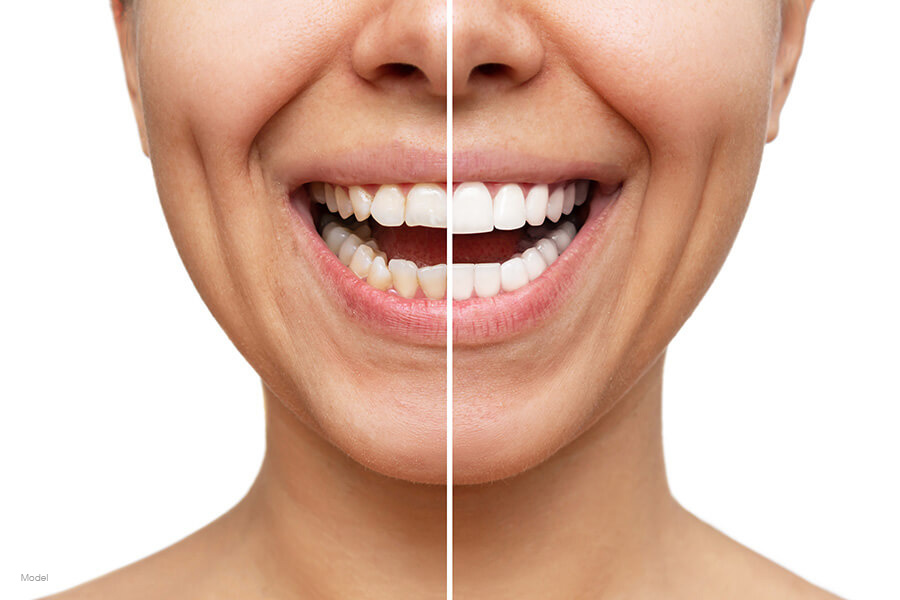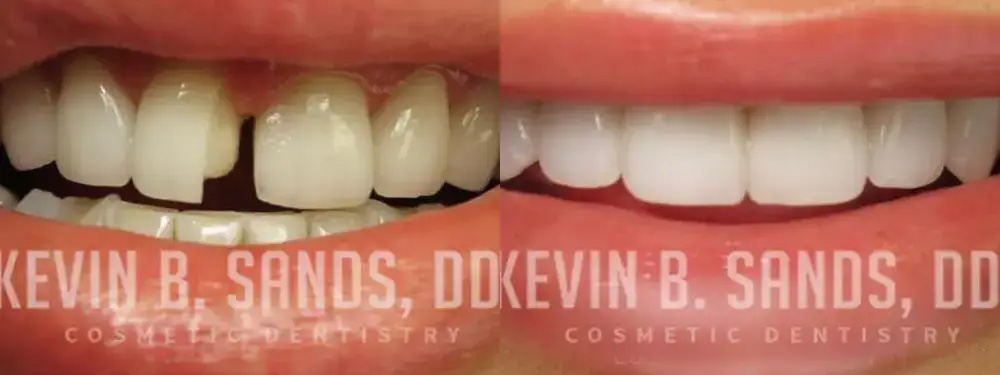
The fastest and easiest way to achieve a perfect smile is with porcelain veneers. This popular cosmetic dentistry treatment produces stunning results, and the process involves simple, straightforward steps that help to ensure a flawless but natural-looking outcome. If you’re interested in porcelain dental veneers, this helpful guide will explain the entire process, from consultation to aftercare.
What Are Porcelain Veneers?
Porcelain veneers are wafer-thin shells crafted from durable ceramic materials, custom-made to match the shape, size, and color of your natural teeth. They are bonded to the front surface of the teeth to enhance their appearance and provide a long-lasting, appealing smile.
Unlike other cosmetic dental treatments, porcelain veneers can correct multiple issues at once, including:
- Dental stains or discoloration that do not respond to teeth whitening
- Minor chips and cracks
- Irregularly shaped or worn-down teeth
- Gaps or slightly misaligned teeth
5 Steps to a Bright and Beautiful Smile
The five basic steps necessary for porcelain veneers include:
- Consultation
- Preparation
- Fabrication
- Placement
- Aftercare
What Will My Initial Consultation for Veneers Be Like?
Your path to a dream smile begins with an exam and discussion about your aesthetic concerns and expectations during an initial consultation.
During this meeting, a qualified cosmetic dentist will evaluate your oral health, discuss your cosmetic goals, answer questions, and determine if porcelain veneers are the best solution for you.
- Oral Examination: If your dentist finds any underlying oral health issues (cavities, gum disease, or infection), they must be treated and resolved before proceeding with veneers.
- Discussion of Goals: You’ll discuss the changes you want to make to your smile, such as whitening, reshaping, or aligning your teeth.
- Treatment Plan: Based on your oral health and cosmetic goals, your dentist will create a personalized treatment plan. This will include the number of veneers you’ll need and the expected timeline.
- Preview of Results: Some dentists use digital imaging or mock-ups to display a preview of how your smile will look with porcelain veneers.
What Does Preparation for Porcelain Veneers Involve?

If you proceed with porcelain veneers, preparation is needed for your teeth to receive them. This involves reshaping the enamel to ensure the veneers fit seamlessly.
- Tooth Reshaping: A small amount of enamel (usually less than a millimeter) is removed from the front surface of each tooth receiving a veneer to ensure a natural fit and prevent the veneers from appearing bulky.
- Impressions: After reshaping your teeth, the dentist will obtain detailed dental impressions or digital scans of your teeth. These physical or digital molds are sent to a professional dental lab or fabricated in the office.
- Shade Selection: Your dentist will help you choose the shade of your veneers so they blend perfectly with your natural or whitened teeth.
- Temporary Veneers: Sometimes, temporary veneers are placed to conceal and protect your altered teeth while your permanent veneers are being made.
How Are Porcelain Veneers Made?
Whether fabricated in a lab or your dentist’s office, the veneer manufacturing process includes:
- A Custom Design: Using the impressions and specifications provided by your dentist, a dental professional or skilled laboratory technician will craft each veneer to match the size, shape, and shade of your untreated or professionally whitened teeth.
- High-Quality Ceramics: Porcelain is a material that is stain-resistant, durable, and can replicate the appearance of natural tooth enamel.
Placement and Bonding
Unless your dentist’s practice is equipped with CEREC® technology, it usually takes one to two weeks to create veneers. When your porcelain veneers are ready, you’ll return to the dentist to have them placed, which is often the most exciting part of the process, as you can see your new smile come to life.
During the bonding process, you can expect:
- A Trial Fitting: Your dentist will place the veneers on your teeth temporarily to ensure they fit perfectly and look natural. Adjustments may be made to the shape, size, or color at this stage.
- A Tooth Cleaning: Each tooth to be treated will be thoroughly cleaned to ensure a secure bond between the veneers and enamel. A professional teeth cleaning is typically recommended before applying veneers.
- The Application of a Bonding Agent: A strong dental adhesive is applied to the surface of your teeth, and the veneers are carefully positioned.
- Curing: A curing light is used to activate and harden the adhesive and securely bond the veneers to your teeth.
- Adjustments and Final Touches: Once the veneers have been placed, your dentist can make any necessary adjustments and polish them for a perfect finish.
Recovery and Aftercare
One benefit of porcelain veneers is that there is minimal downtime involved. Most patients can return to their regular activities immediately after the procedure.
Immediate aftercare tips:
- It’s common to experience mild sensitivity to hot or cold foods and beverages for a few days after the procedure. Eat and drink accordingly. This after-effect should subside as your teeth adjust.
- Eat only soft foods the first day or two after dental veneer placement to avoid putting excess pressure on your new veneers.
Long-Term Maintenance
While porcelain veneers are durable and stain-resistant, vigilant care is needed to keep them looking their best.
- Proper Oral Hygiene: Brush and floss regularly to keep your veneers looking bright and to maintain your overall oral health. While porcelain is resistant to decay, the underlying teeth and gums still require proper care.
- Avoid Hard or Chewy Foods: Avoid biting down on hard non-food items, such as pencils, pens, and even ice, to prevent chipping or damage.
- Limit Exposure to Highly Pigmented Beverages and Foods: If you regularly consume red wine, tea, coffee, dark juices, or fruits, be sure to brush afterward. Your veneers resist stains but can become dull with extended exposure to discoloring food or drinks.
- Regular Check Ups: Visit your dentist regularly for exams and professional cleanings to ensure your veneers remain in top condition.
Are Porcelain Veneers Right for You?
Porcelain veneers are an exceptional way to correct cosmetic dental problems. However, they may not be right for everyone.
Ideal candidates will:
- Have healthy teeth and gums
- Be seeking to correct cosmetic dental imperfections
- Be committed to maintaining good oral hygiene
Are not ideal for:
- Patients with active gum disease or tooth decay
- Those who grind or clench their teeth excessively (may require a night guard to protect veneers)
Best Porcelain Veneer Results in Beverly Hills, CA
From your initial consultation to their application and maintenance, porcelain veneers are designed to deliver beautiful, long-lasting results. Our well-known celebrity dentist, Dr. Kevin Sands, offers dental bonding and high-quality porcelain veneers in the Greater Los Angeles area, including Beverly Hills and beyond.

See Dr. Sands’ dental veneer before and after photos and call 310.273.0111 to schedule your consultation.